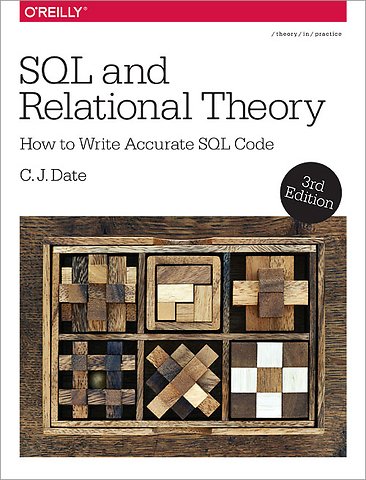

C.J. Date has a stature that is unique within the database industry. C.J. is a prolific writer, and is well-known for his best-selling textbook: An Introduction to Database Systems (Addison Wesley).
Meer over C.J. DateSQL and Relational Theory
How to Write Accurate SQL Code
Paperback Engels 2015 3e druk 9781491941171Samenvatting
SQL is full of difficulties and traps for the unwary. You can avoid them if you understand relational theory, but only if you know how to put that theory into practice. In this book, Chris Date explains relational theory in depth, and demonstrates through numerous examples and exercises how you can apply it to your use of SQL.
This third edition has been revised, extended, and improved throughout. Topics whose treatment has been expanded include data types and domains, table comparisons, image relations, aggregate operators and summarization, view updating, and subqueries. A special feature of this edition is a new appendix on NoSQL and relational theory.
- Could you write an SQL query to find employees who have worked at least once in every programming department in the company? And be sure it’s correct?
- Why is proper column naming so important?
- Nulls in the database cause wrong answers. Why? What you can do about it?
- How can image relations help you formulate complex SQL queries?
- SQL supports "quantified comparisons," but they’re better avoided. Why? And how?
Database theory and practice have evolved considerably since Codd first defined the relational model, back in 1969. This book draws on decades of experience to present the most up to date treatment of the material available anywhere. Anyone with a modest to advanced background in SQL can benefit from the insights it contains. The book is product independent.
Specificaties
Lezersrecensies
Inhoudsopgave
1. Setting the Scene
-The relational model is much misunderstood
-Some remarks on terminology
-Principles not products
-A review of the original model
-Model vs. implementation
-Properties of relations
-Base vs. derived relations
-Relations vs. relvars
-Values vs. variables
-Concluding remarks
-Exercises
-Answers
2. Types and Domains
-Types and relations
-Equality comparisons
-Data value atomicity
-What’s a type?
-Scalar vs. nonscalar types
-Scalar types in SQL
-Type checking and coercion in SQL
-Collations in SQL
-Row and table types in SQL
-Concluding remarks
-Exercises
-Answers
3. Tuples and Relations, Rows and Tables
-What’s a tuple?
-Rows in SQL
-What’s a relation?
-Relations and their bodies
-Relations are n-dimensional
-Relational comparisons
-TABLE_DUM and TABLE_DEE
-Tables in SQL
-Column naming in SQL
-Concluding remarks
-Exercises
-Answers
4. No Duplicates, No Nulls
-What’s wrong with duplicates?
-Duplicates: further issues
-Avoiding duplicates in SQL
-What’s wrong with nulls?
-Avoiding nulls in SQL
-A remark on outer join
-Concluding remarks
-Exercises
-Answers
5. Base Relvars, Base Tables
-Updating is set level
-Relational assignment
-More on candidate keys
-More on foreign keys
-Relvars and predicates
-Relations vs. types
-Exercises
-Answers
6. SQL and Relational Algebra I: The Original Operators
-Some preliminaries
-More on closure
-Restriction
-Projection
-Join
-Union, intersection, and difference
-Which operators are primitive?
-Formulating expressions one step at a time
-What do relational expressions mean?
-Evaluating SQL table expressions
-Expression transformation
-The reliance on attribute names
-Exercises
-Answers
7. SQL and Relational Algebra II: Additional Operators
-Exclusive union
-Semijoin and semidifference
-Extend
-Image relations
-Divide
-Aggregate operators
-Image relations revisited
-Summarization
-Summarization revisited
-Group, ungroup, and relation valued attributes
-“What if” queries
-A note on recursion
-What about ORDER BY?
-Exercises
-Answers
8. SQL and Constraints
-Type constraints
-Type constraints in SQL
-Database constraints
-Database constraints in SQL
-Transactions
-Why database constraint checking must be immediate
-But doesn’t some checking have to be deferred?
-Constraints and predicates
-Miscellaneous issues
-Exercises
-Answers
9. SQL and Views
-Views are relvars
-Views and predicates
-Retrieval operations
-Views and constraints
-Update operations
-What are views for?
-Views and snapshots
-Exercises
-Answers
10. SQL and Logic
-Why do we need logic?
-Simple and compound propositions
-Simple and compound predicates
-Quantification
-Relational calculus
-More on quantification
-Some equivalences
-Concluding remarks
-Exercises
-Answers
11. Using Logic to Formulate SQL Expressions
-Some transformation laws
-Example 1: Logical implication
-Example 2: Universal quantification
-Example 3: Implication and universal quantification
-Example 4: Correlated subqueries
-Example 5: Naming subexpressions
-Example 6: More on naming subexpressions
-Example 7: Dealing with ambiguity
-Example 8: Using COUNT
-Example 9: Another variation
-Example 10: UNIQUE quantification
-Example 11: ALL or ANY comparisons
-Example 12: GROUP BY and HAVING
-Exercises
-Answers
12. Miscellaneous SQL Topics
-SELECT *
-Explicit tables
-Dot qualification
-Range variables
-Subqueries
-“Possibly nondeterministic” expressions
-Empty sets
-A simplified BNF grammar
-Exercises
-Answers
Appendix A: The Relational Model
Appendix B: SQL Departures from the Relational Model
Appendix C: A Relational Approach to Missing Information
Appendix D: A Tutorial D Grammar
Appendix E: Summary of Recommendations
Appendix F: NoSQL and Relational Theory
Appendix G: Suggestions for Further Reading
Index
Anderen die dit boek kochten, kochten ook
Rubrieken
- advisering
- algemeen management
- coaching en trainen
- communicatie en media
- economie
- financieel management
- inkoop en logistiek
- internet en social media
- it-management / ict
- juridisch
- leiderschap
- marketing
- mens en maatschappij
- non-profit
- ondernemen
- organisatiekunde
- personal finance
- personeelsmanagement
- persoonlijke effectiviteit
- projectmanagement
- psychologie
- reclame en verkoop
- strategisch management
- verandermanagement
- werk en loopbaan





